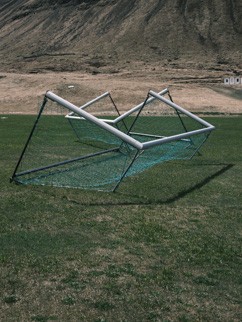Malo Legrand
- Résidence mer calme #3
Arctic Lab




























In the austere vastness of the Westfjords, nature may, at first glance, seem indifferent, almost impassive. From the deck of the “Peter Pan,” the sailboat that will be my refuge for the next six weeks, I gaze upon these grand landscapes where the icy wind carves through the mountains, while the ocean blends into the sky to infinity. Yet, with closer attention, I realize that even here, at the northernmost corners of Europe, nature is no longer untouched by the traces of humanity or the relentless test of climate change. This once wild and youthful territory now bears the visible scars of a world in transformation.
The last snowstorms have left scattered patches across the hills this June. Slowly, under the shy rays of the sun, they melt away to reveal a dry, almost exhausted earth. The streams born from the melting snow meander silently, ephemeral, before vanishing into the mute valleys. The Icelandic landscape, once untamed, is now a fragile witness to the climatic upheavals that are redefining it.
Everywhere, the impact of humanity is felt, like the abandoned industrial building at the foot of a mountain, a relic of a mechanical dream to which nature never consented. Man sought to shape this harsh space in his image, but nature, in its unalterable wisdom, always reclaims its rights. Concrete cracks, machines rust, while the fjords continue their inexorable erosion, indifferent to human presence.
Even fishing, the ancestral activity symbolizing the balance between man and environment, now seems swept into a desperate race against time. The fish, piled beneath the ice, bear the marks of exploitation struggling to adapt to new realities. Marine ecosystems are transforming, disturbed by ocean acidification and rising temperatures. Man, once in harmony with his surroundings, now faces a nature he can no longer control, and whose reactions can prove devastating.
The basalt mountains, with their imposing geological formations, seem timeless. Yet they tell a story of erosion, of constant transformation. Natural forces continue to work, slowly but surely erasing the traces of our passage. Roads collapse, cliffs crumble, and green moss spreads like a mantle of rebirth, indifferent to humanity’s desire to leave a lasting mark.
This paradox is also embodied by these cairns, stacks of stones meant to guide travelers, but here, they become immense snow barriers, symbols of the fragility of our existence in the face of a nature we can no longer master. Each day spent here, in this almost absolute solitude, deepens in me a profound sense of humility. The neon green moss, covering the wet land and bursting with life, seems unreal in its resilience. It reminds me, with almost insolent vitality, that even in the face of our mistakes, nature adapts, survives, and is reborn. But at what cost? How much will we have to erase ourselves in order for this balance to be restored?
As an artist, I am here to bear witness to this transition, to immortalize a world that is disappearing. The photographs I capture become living archives, fragments of a landscape that evolves before our eyes. Each image is a desperate attempt to capture the fleeting beauty of these places, a beauty that slips through my fingers, like the water from the streams born of the last snows. Nature teaches me a lesson I cannot ignore: it will survive, but man must relearn his place in this balance, or risk disappearing under the forces he himself has awakened.
Iceland, with its collapsing glaciers, warming seas, and crumbling mountains, is not just a landscape; it is the allegory of our time. It reflects a world we must transform before it’s too late. In every detail of this territory, I perceive the struggle between the ephemeral and the eternal, between man and nature, and I can’t help but wonder: will we be able to hear this warning before it’s too late?